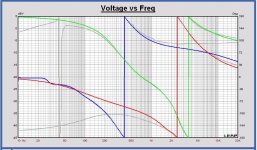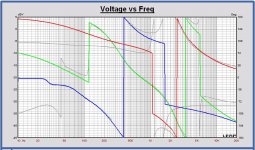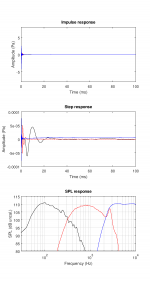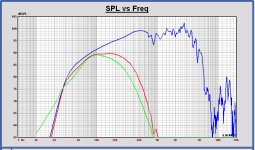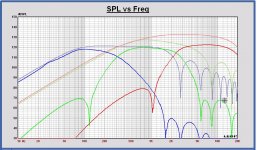Just to check: can you show a comparison of the phase curves of the biquads and the Vituix simulation?
The phases of the xo transfers of biquads and Vituix targets are equal in the passband and loosing target far outband.
In the plots, the grey curves are the targets. Woofer = bleu, midrange = green and tweeter = red.
For the SPL plots in post 698 I didn't apply the AC offset between the drivers, I think about that just now. So the SPL sum can be a little different from the Vituix simulation.
Attachments
Last edited:
Hello,
That is a nice project you have here!
Seems like a lot of fun
In rePhase you typically target a given acoustical response (eg textbook LR) based on an actual measurement: you can for example set a minimum-phase filter in "compensate" mode to the desired target and then work your way with EQs and filters to get a flat response curve.
The primary use is to generate a FIR for a convolution device or software, but you can also use rePhase as a simulation tool and report the corrections in an IIR device (provided you only used minimum-phase corrections that the target IIR device can implement).
That is a nice project you have here!
Seems like a lot of fun
Just had a quick look at those. I may be wrong, but Equalizer APO and rePhase seem to be targeted at "textbook" filter functions and are a bit more complicated than what we need. The miniDSP spreadsheet is also "just" for textbook filter functions.
In rePhase you typically target a given acoustical response (eg textbook LR) based on an actual measurement: you can for example set a minimum-phase filter in "compensate" mode to the desired target and then work your way with EQs and filters to get a flat response curve.
The primary use is to generate a FIR for a convolution device or software, but you can also use rePhase as a simulation tool and report the corrections in an IIR device (provided you only used minimum-phase corrections that the target IIR device can implement).
Hi Pos,
Rephase is a very interesting tool to make the speaker phase linear. I used it in the past and did the phase compensation on the sum SPL in software on the digital stream.
What, in your opinion, is the most easy way to do the phase compensation in a hardware device? At this moment we do the filter minimum phase design in miniDSP. I don't think the phase compensation can be realized with IIR functionality?
Just as information, to not go too much off topic now... thanks
Maybe interesting to design later a phase compensation for the Monkey Box in software to make the speaker phase linear together with the passive xo.
For those who might be interested in it...
Rephase is a very interesting tool to make the speaker phase linear. I used it in the past and did the phase compensation on the sum SPL in software on the digital stream.
What, in your opinion, is the most easy way to do the phase compensation in a hardware device? At this moment we do the filter minimum phase design in miniDSP. I don't think the phase compensation can be realized with IIR functionality?
Just as information, to not go too much off topic now... thanks
Maybe interesting to design later a phase compensation for the Monkey Box in software to make the speaker phase linear together with the passive xo.
For those who might be interested in it...
Last edited:
Hi Paul,
rephase is not limited to phase linear filters, or phase linearization: you can build or simulate any kind of filter with it, including minimum-phase.
If you want to linearize the phase of an existing passive or active minimum-phase filter the easiest way is to do it in the player software, using a convolution engine in your favorite player, when such an option is available (eg foobar or jriver).
You can also use an openDRC.
rephase is not limited to phase linear filters, or phase linearization: you can build or simulate any kind of filter with it, including minimum-phase.
If you want to linearize the phase of an existing passive or active minimum-phase filter the easiest way is to do it in the player software, using a convolution engine in your favorite player, when such an option is available (eg foobar or jriver).
You can also use an openDRC.
It's been a while now...
I have listened to the DSP implementations of the "Conventional 3B" and the "Elliptic 3.4mix" filters described in post 685. The overall sound of both filters is very similar, and at the beginning it was surprisingly hard to tell them apart. As always, these things take a while to figure out. The sound of the Elliptic 3.4 mix is a bit more transparent, which becomes apparent especially when complex music is playing (several instruments and vocals playing at the same time). Going from the Conventional 3B to the Elliptic 3.4 mix is a bit like going from a good amplifier to a better amplifier. Both filters work well, but the EL is a bit better. The only gripes I have at the moment is that the bass is a bit "anemic". The bass itself is very good, but the overall sound balance could benefit from a bit more bass.
Since it's hard to do meaningful farfield acoustic measurements below 300 Hz or so, I did some nearfield measurements (attached). I was a bit surprised to see that the nearfield SPL levels were essentially the same for the woofer and the mid/tweeter (note that the absolute SPL level is not calibrated with the miniDSP/active setup, but the relative SPL differences are correct). With the baffle step kicking in the farfield (where my ears are), it's no surprise the bass is "anemic". Did we make a mistake with the baffle step modeling / low-frequency splicing somewhere along the road?
Let me know what you think.
P.S.: please don't worry about the 2.5 kHz peak of the midrange nearfield measurement (see earlier discussions).
I have listened to the DSP implementations of the "Conventional 3B" and the "Elliptic 3.4mix" filters described in post 685. The overall sound of both filters is very similar, and at the beginning it was surprisingly hard to tell them apart. As always, these things take a while to figure out. The sound of the Elliptic 3.4 mix is a bit more transparent, which becomes apparent especially when complex music is playing (several instruments and vocals playing at the same time). Going from the Conventional 3B to the Elliptic 3.4 mix is a bit like going from a good amplifier to a better amplifier. Both filters work well, but the EL is a bit better. The only gripes I have at the moment is that the bass is a bit "anemic". The bass itself is very good, but the overall sound balance could benefit from a bit more bass.
Since it's hard to do meaningful farfield acoustic measurements below 300 Hz or so, I did some nearfield measurements (attached). I was a bit surprised to see that the nearfield SPL levels were essentially the same for the woofer and the mid/tweeter (note that the absolute SPL level is not calibrated with the miniDSP/active setup, but the relative SPL differences are correct). With the baffle step kicking in the farfield (where my ears are), it's no surprise the bass is "anemic". Did we make a mistake with the baffle step modeling / low-frequency splicing somewhere along the road?
Let me know what you think.
P.S.: please don't worry about the 2.5 kHz peak of the midrange nearfield measurement (see earlier discussions).
Attachments
... The only gripes I have at the moment is that the bass is a bit "anemic". The bass itself is very good, but the overall sound balance could benefit from a bit more bass.
...
I cannot help but wonder if it's not actually the low mid that may be a bit lean...?
The mid rolls off fast, maybe there's something missing between ca 150-400hz somewhere?
80-120hz looks about "ok" on the squiggly line?
Try switching to a more relaxed roll off on only the 12" just to see what happens, maybe there is something we can tweak. Or maybe going the opposite direction with a sharper roll off on just the 12" might sum the drivers better.
I cannot help but wonder if it's not actually the low mid that may be a bit lean...?
The mid rolls off fast, maybe there's something missing between ca 150-400hz somewhere?
80-120hz looks about "ok" on the squiggly line?
Remember that the baffle step is not included in the near field measurement. If you take this into account, the bass will be up to 6 dB lower.
The exact shape of the baffle step is not simple to determine, though. It might be possible to model or measure it in the free field (outdoors, on a "tower" to get away from the floor reflections). Not sure what's the most meaningful approach for in-room situations.
Hi Matthias
You have the same experience using the elliptical version playing complex music.
That is one of the good points of such xo filter concept, in a way music gives you a better trigger and life experience. Sound becomes more fast in some way.
If I understood it well, you are still listening with a mono setup?
If this is the case, it is difficult to hear if the bass balance is ok, just my opinon.
Maybe some tuning of the low frequency response shape below 100Hz is some option to improve the bass perception, later on.
In attach some simulation results to compare your nearfield measurement with.
The farfield response of the woofer without xo at 1m in blue and with xo in red. The simulated nearfield response with xo in green (scaled). Quite consistent with your nearfield measurement. I used the voltage xo transfer of the EL34mix digital xo version.
You have the same experience using the elliptical version playing complex music.
That is one of the good points of such xo filter concept, in a way music gives you a better trigger and life experience. Sound becomes more fast in some way.
If I understood it well, you are still listening with a mono setup?
If this is the case, it is difficult to hear if the bass balance is ok, just my opinon.
Maybe some tuning of the low frequency response shape below 100Hz is some option to improve the bass perception, later on.
In attach some simulation results to compare your nearfield measurement with.
The farfield response of the woofer without xo at 1m in blue and with xo in red. The simulated nearfield response with xo in green (scaled). Quite consistent with your nearfield measurement. I used the voltage xo transfer of the EL34mix digital xo version.
Attachments
I am not (yet) concerned about the shapes of the filter curves around the woofer/mid x-over point.
My concern is more fundamental. The max. SPL levels of the nearfield measurements of the woofer and the midrange (and the tweeter) show up at approximately the same level (see post 708). In the far field, you need to take into account the baffle step, which is centered around 300 Hz for the Monkey Coffin (using this simple formula). This means that the max. bass SPL (woofer) would be up to 6 dB lower than max. SPL of the midrange driver in the farfield.
Should we try a shorter bass reflex port?
My concern is more fundamental. The max. SPL levels of the nearfield measurements of the woofer and the midrange (and the tweeter) show up at approximately the same level (see post 708). In the far field, you need to take into account the baffle step, which is centered around 300 Hz for the Monkey Coffin (using this simple formula). This means that the max. bass SPL (woofer) would be up to 6 dB lower than max. SPL of the midrange driver in the farfield.
You mean below 100Hz Kaffimann?
I think some more flat SPL down to about 60-70 Hz is missing now. And then a linear SPL roll off to 30 Hz would be better maybe.
Should we try a shorter bass reflex port?
Remark that the nearfield SPL of a smaller driver is higher for the same SPL at 1 meter distance. Simply because the piston Sd of a little driver is smaller and the acceleration has to be higher for the same SPL at 1 meter.
In the plot the simulated nearfield responses of the three drivers without and with xo. The filtered curves in the more dark color. Almost conform your measurements, but the absolute nearfield level is difficult to measure very accurately.
Making the port shorter is an option, but it means a new low frequency design...
In the plot the simulated nearfield responses of the three drivers without and with xo. The filtered curves in the more dark color. Almost conform your measurements, but the absolute nearfield level is difficult to measure very accurately.
Making the port shorter is an option, but it means a new low frequency design...
Attachments
Last edited:
Remark that the nearfield SPL of a smaller driver is higher for the same SPL at 1 meter distance. Simply because the piston Sd of a little driver is smaller and the acceleration has to be higher for the same SPL at 1 meter.
Argh, of course! Brain malfunction on my side!
Far field SPL is proportional to sqrt(Sd) x nearfield-SPL. With woofer Sd = 489 cm^2 and midrange Sd = 57 cm^2, the woofer would theoretically be be louder than the midrange by a factor of 2.9 (ignoring the waveguide of the mid). Taking into account the baffle step, things should get levelled out more of less.
- Home
- Loudspeakers
- Multi-Way
- Open Source Monkey Box
